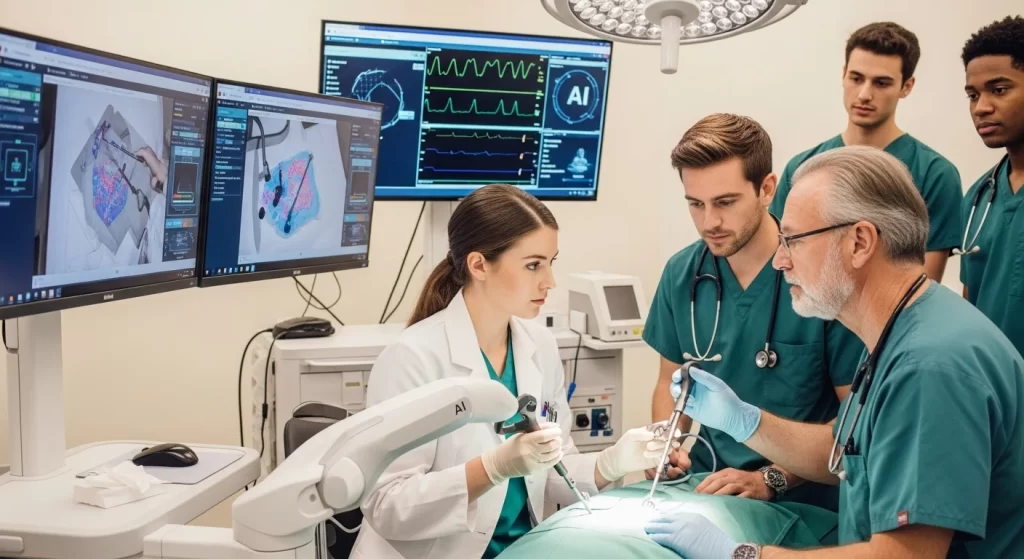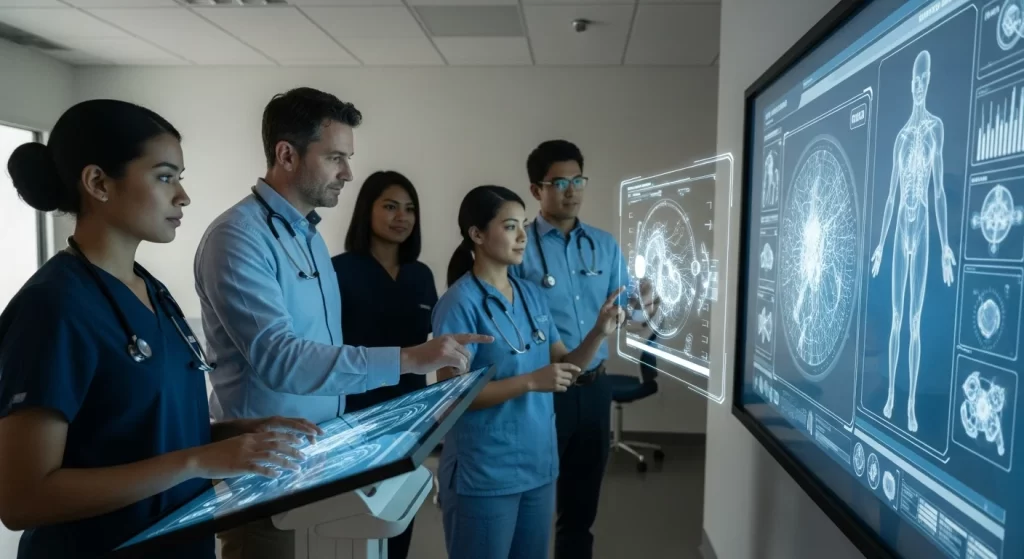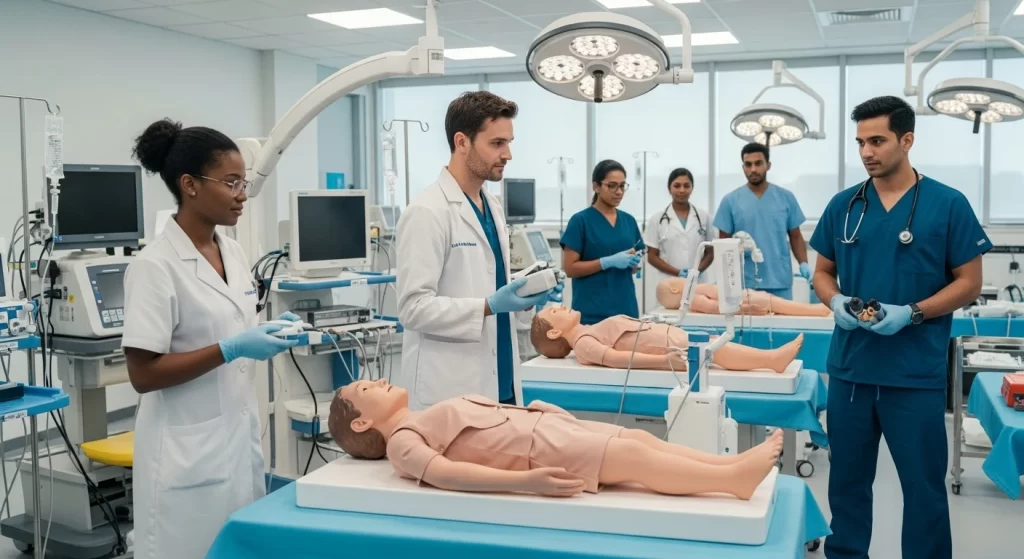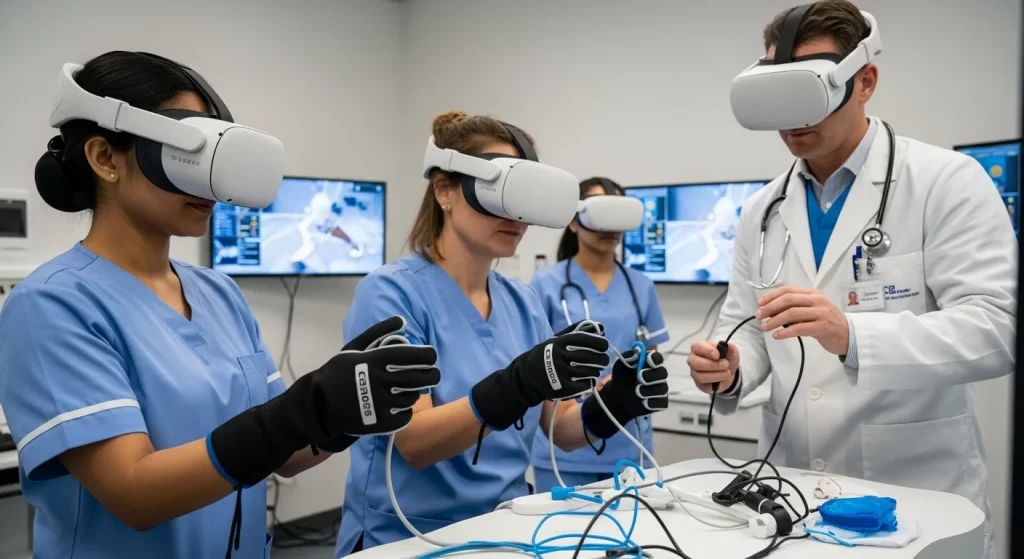The healthcare landscape is undergoing a period of unprecedented technological acceleration, compelling a re-evaluation of how medical professionals are trained. Central to this transformation is Artificial Intelligence (AI), a technology whose impact is increasingly palpable. The economic momentum is undeniable; the global AI in healthcare market, valued significantly in recent years, is projected by analysts to experience massive growth, with some forecasts suggesting figures in the hundreds of billions by 2030. Concurrently, the AI education market is also poised for dramatic expansion. This substantial investment highlights an urgent need for healthcare professionals adept at leveraging these powerful new tools, fundamentally reshaping medical education.

At the heart of this educational revolution is AI medical training, encompassing diverse AI applications designed to enhance the education and skill development of medical personnel. Beyond isolated tools, the AI hospital is emerging as a dedicated, immersive environment for medical training. These are not mere digital replicas but integrated ecosystems designed to simulate real-world healthcare complexities, offering a new paradigm for medical AI training.
AI hospitals, powered by sophisticated AI medical training tools, represent a significant departure from traditional methods. They aim to cultivate highly skilled, adaptable healthcare professionals prepared for modern medicine’s multifaceted challenges. This is critical for realizing AI’s clinical benefits. The scale of investment in AI implies a corresponding demand for a proficient workforce, acting as a catalyst for innovation in training. AI hospitals also address limitations in traditional training, such as providing consistent, high-quality education across diverse settings, the high costs of traditional simulation, and variable access to a broad spectrum of clinical cases, especially in remote regions.
The journey into AI-driven healthcare is complex. However, SPsoft has deep expertise in creating and integrating AI tools that boost medical training!
Deconstructing the AI Hospital: More Than Just Virtual Walls
An “AI Hospital” for medical education is an integrated ecosystem of advanced AI technologies, curated datasets, and dynamic simulated environments. These components replicate real-world clinical settings, patient encounters, and medical workflows, all tailored for training. Tsinghua University’s “Agent Hospital” project, aiming to simulate a comprehensive hospital environment with 21 clinical departments and a “time-compression engine” for accelerated learning, illustrates this concept. AI hospitals are tangible training platforms.
The architecture of an AI training hospital includes several key components:
- Advanced Simulation Platforms. AI-driven virtual patients, AI-enhanced high-fidelity manikins (like Nasco Healthcare’s ALEX and AXEL), and immersive Virtual Reality (VR) and Augmented Reality (AR) environments.
- Data Integration & Analytics. Systems for collecting and analyzing trainee performance data, enabling personalized feedback and adaptive learning pathways, often using ethically generated synthetic data.
- AI Tutors and Intelligent Systems. AI programs guiding learners, responding to queries, and objectively assessing skill acquisition.
- Connectivity and Accessibility. Robust IT infrastructure, potentially leveraging 5G for remote access and telemedicine training, as envisioned in Tsinghua’s AI hospital.
- Curriculum Integration Frameworks. Thoughtful embedding of AI tools within structured curricula, amplifying effectiveness through cohesive educational strategies.
The AI hospital as a data-rich learning ecosystem signifies a profound shift. Every interaction becomes a data point for analysis, allowing the AI hospital to function as a dynamic educational laboratory. Trainee performance is continuously monitored to personalize learning and refine training programs, offering responsiveness difficult to achieve traditionally. This marks a progression from disparate AI tools to holistic, integrated training environments, facilitating complex, multi-stage scenario training that mirrors real-world patient journeys and interdepartmental collaboration.
The Transformative Power of AI Medical Training
The integration of AI into medical training promises a profound transformation in skill acquisition, impacting patient care and safety.

Personalized and Adaptive Learning Pathways
AI moves beyond one-size-fits-all education. Systems analyze individual student performance, pinpoint weaknesses, and tailor content, pace, and delivery. Intelligent Tutor Systems (ITS) adapt to evolving understanding, optimizing learning efficiency. Studies show medical students using AI-based adaptive learning achieve higher mastery rates.
Enhanced Diagnostic Acumen and Clinical Reasoning
AI tools sharpen diagnostic skills. Trainees encounter vast simulated clinical cases, including rare conditions. AI can analyze medical images or patient data, highlighting subtle indicators and providing immediate feedback. Research suggests AI-driven medical training can boost diagnostic accuracy significantly, with advanced models like GPT-4 performing diagnostic tasks comparably to expert clinicians. AI simulations also improve clinical decision-making more effectively than traditional methods alone.
Mastering Complex Procedures and Surgical Skills in Risk-Free Settings
For skill-intensive specialties, AI-powered simulations (VR, robotic simulators) offer revolutionary training. Trainees practice intricate procedures without patient risk. Surgeons trained with AI-enhanced simulators have shown superior performance. AI provides real-time guidance and feedback during simulated surgeries. Systems like the da Vinci Surgical System integrate AI into surgical training. Simulation-based methods, often AI-enhanced, accelerate procedural skill acquisition.
Improving Patient Safety and Healthcare Efficiency
Better-prepared professionals from AI medical training lead to more accurate diagnoses, effective treatments, and safer procedures, improving patient outcomes and system efficiency. AI can also reduce cognitive load by automating routine tasks.
The accessibility of AI medical training platforms can democratize high-level training, offering remote access to diverse scenarios and expert feedback, mitigating geographical and institutional disparities. The combination of personalized strategies, realistic simulations, and immediate feedback can accelerate learning, potentially shortening proficiency timelines. Beyond specific skills, AI training environments present novel scenarios, cultivating “adaptive expertise”—the ability to apply knowledge flexibly to unfamiliar situations, fostering critical thinking essential for real-world medicine.
Inside the AI-Powered Arsenal: Tools Changing Medical Education
The revolution in AI medical training is driven by a diverse arsenal of technological tools fundamentally reshaping the educational landscape.

AI-Driven Simulations: The Core of Modern Training
- Virtual Patients (VPs). Interactive, AI-based programs simulating real patients, exhibiting symptoms, and responding to interventions. They offer practice in clinical skills, diagnosis, treatment planning, and communication, with AI providing feedback. “Synthetic patients” can simulate difficult conversations.
- Virtual Reality (VR) and Augmented Reality (AR). Immersive technologies for practicing complex procedures, exploring anatomy, and navigating clinical scenarios, with AI enhancing responsiveness.
Intelligent Tutoring Systems (ITS) and AI-Driven Feedback
- ITS emulates one-on-one tutoring, identifying knowledge gaps and creating tailored educational pathways.
- AI algorithms integrated into various tools provide real-time, objective feedback during diagnostic exercises or simulated procedures, allowing rapid self-correction.
Generative AI for Dynamic Scenario Creation
- Generative AI models create vast, diverse clinical scenarios, including low-frequency, high-risk situations. Companies like John Snow Labs leverage this for advanced simulations. It’s also used for creating synthetic patient data, protecting real patient privacy.
Robotic Simulators with AI Enhancements
- Advanced physical simulators like the da Vinci Surgical System integrate AI for performance tracking, feedback, and adaptive training scenarios, offering realistic tactile feedback for surgical skills.
AI-Powered Chatbots and Games
- AI chatbots serve as educational assistants, answering queries, summarizing research, or practicing communication.
- AI-enhanced educational games offer customized, immersive learning, adjusting difficulty to maintain engagement and optimize knowledge retention.
These tools create powerful feedback loops, with AI’s immediacy and objectivity allowing rapid error recognition and correction, accelerating skill refinement. This signals a pedagogical shift towards experiential learning, integrating knowledge acquisition and skill practice from earlier stages. Furthermore, these tools cultivate “meta-skills” like critical thinking, adaptability, and ethical reasoning by presenting novel, ambiguous scenarios.
Table 1. Key AI Tools in Medical Training and Their Applications
| AI Tool Category | Description | Key Training Applications |
|---|---|---|
| Virtual Patients (VPs) | AI-driven simulated patients exhibiting symptoms and responding to interventions. | Clinical reasoning, diagnostic skills, communication, patient interaction, decision-making. |
| VR/AR Simulators | Immersive 3D environments for procedural and anatomical training. | Surgical skills, procedural practice (e.g., catheterization), anatomical understanding, emergency response. |
| Intelligent Tutors (ITS) | AI systems providing personalized guidance, feedback, and adaptive learning paths. | Knowledge acquisition, problem-solving, personalized study plans, remediation of weak areas. |
| Generative AI | AI that creates new content, such as diverse clinical scenarios or synthetic patient data. | Exposure to rare cases, complex decision-making, ethical dilemma simulation, AI model training. |
| Robotic Simulators | Physical simulators (e.g., for surgery) enhanced with AI for feedback and performance tracking. | Advanced surgical techniques, psychomotor skills, team coordination in OR settings (e.g., da Vinci system). |
| AI Chatbots | AI programs for conversational interaction, information retrieval, and basic skill practice. | Medical knowledge recall, patient communication practice (text-based), information summarization. |
| AI-Enhanced Games | Gamified learning experiences that adapt to user performance to enhance engagement and knowledge retention. | Foundational medical knowledge, decision-making under pressure (gamified), adherence to protocols. |
The Tsinghua AI Hospital and Other Pioneering Efforts
Specific projects and institutional adoption showcase AI’s transformative potential in medical training.
Tsinghua University’s “Agent Hospital” aims to simulate a complete hospital with 21 clinical departments. Its “time-compression engine” rapidly simulates entire patient care cycles, accelerating medical training and broadening healthcare knowledge access, especially in remote or conflict zones. It’s designed to assist doctors by reducing administrative burdens. AI “doctors” can diagnose patients, and AI-driven triage systems are included, with plans for Traditional Chinese Medicine modules.
The project aims to alleviate healthcare system pressure, manage routine cases remotely, save treatment time, reduce patient financial burdens, and provide reliable guidance. It has garnered international interest, with a strong emphasis on anonymized data and adherence to cybersecurity and ethics protocols.
Other Pioneering Efforts in AI Medical Training
The momentum extends beyond large-scale projects:
- AI for Clinical Skills Assessment. Medical schools like the University of Minnesota (UMN) and UT Health San Antonio use AI for assessing clinical skills through interactions with AI-generated standardized patients and analyzing recordings of interactions with human standardized patients.
- AI for Test Preparation and Personalized Learning. The University of Cincinnati (UC) College of Medicine developed an AI tool to generate USMLE-style practice questions. UT Health San Antonio uses AI to create and grade targeted quizzes.
- Curriculum Integration and Specialized Programs. Schools like George Washington School of Medicine and Health Sciences (GW SMHS) offer AI electives. Harvard Medical School has an “AI in Medicine PhD,” and UT Health San Antonio offers a dual Medicine and AI degree. Icahn School of Medicine at Mount Sinai provides students access to tools like ChatGPT Edu.
These examples underscore a multifaceted adoption trend. The Tsinghua project’s aim for remote areas suggests AI training hospitals could be global equalizers, offering high-quality education irrespective of local resources. Such AI hospitals also function as sandboxes for testing clinical AI algorithms before real-world deployment, de-risking adoption. The progression in medical schools from pilot efforts to comprehensive curriculum reforms signals AI’s systemic embedding into medical education.
Challenges and Ethical Considerations in AI Medical Training
Widespread AI implementation in medical training requires navigating complex challenges and ethical considerations.
Ethical Dilemmas:
- Algorithmic Bias. AI trained on non-diverse datasets can perpetuate or amplify societal biases, affecting training scenarios and assessments.
- Data Privacy and Confidentiality. Using large data volumes raises concerns about privacy and secure handling of sensitive information, requiring adherence to regulations like HIPAA and GDPR.
- Informed Consent. Consent is needed from patients whose data might be used and from trainees regarding AI’s role in their education.
- Transparency and Explainability (The “Black Box” Problem). Opaque AI decision-making processes can hinder trainee understanding and critical assessment.
- Accountability and Liability. Determining responsibility for AI errors or trainee mistakes based on AI guidance is complex, especially with AI “hallucinations.”
- Cultural Differences. AI tools developed in one cultural context may not be universally applicable, potentially leading to culturally insensitive training.
Technical and Practical Hurdles:
- High Development and Implementation Costs. Sophisticated AI tools can be expensive, creating access disparities.
- Integration with Existing Curricula. Embedding AI tools requires careful planning, curriculum redesign, IT infrastructure, and faculty engagement. The challenge is often translating pilots into routine practice.
- Need for Specialized Faculty and Training. Educators need training to effectively use AI tools and guide students.
- Cybersecurity Risks. AI systems and their data are targets for cyberattacks, requiring robust security.
- Resistance to Change. Reluctance to adopt new technologies can hinder progress.
- Digital Divide and Equity of Access. Benefits may not be equitably distributed, potentially widening gaps between institutions.
Algorithmic bias presents a “dual bias” risk: biased AI algorithms and culturally biased pedagogical approaches. The rapid pace of AI development outstrips ethical guidelines and regulatory frameworks, creating a “gray zone.” The role of human educators will evolve from information dispensers to facilitators of AI-driven learning, curators of AI content, and guides on ethical AI use, requiring new skills for educators.
Table 2. Benefits vs. Challenges of AI in Medical Training
| Aspect | Benefits | Challenges |
|---|---|---|
| Learning Experience | Personalized/adaptive learning, enhanced engagement, access to vast/diverse cases, real-time feedback. | Over-reliance/deskilling, difficulty replicating human nuance, need for educator training. |
| Skill Development | Improved diagnostic accuracy, enhanced decision-making, faster procedural skill acquisition, safe practice for complex/surgical skills. | Algorithmic bias impacting skill assessment, “black box” hindering deep understanding. |
| Accessibility & Equity | Potential for remote access, standardized training, access to expertise for underserved areas. | High costs, digital divide, infrastructure requirements. |
| Ethical Considerations | (Indirect benefits, e.g., improved patient safety from better training) | Data privacy, algorithmic bias, accountability, transparency, informed consent. |
| Implementation | Increased efficiency in training, potential for reduced training time. | Integration into curricula, resistance to change, cybersecurity, regulatory hurdles. |
AI Shaping the Next Generation of Healthcare Professionals
AI’s integration into medical training is a foundational shift. The future promises more sophisticated applications, deeper curricular integration, and a new human-AI symbiosis.

- Evolution of AI Medical Training. Methodologies will become more integrated and mainstream. Multimodal AI models processing diverse data types (text, images, voice) will create more realistic simulations. Generative AI for high-quality synthetic patient data will expand training datasets while protecting privacy.
- Curriculum Overhaul. Comprehensive curriculum changes are essential, embedding AI literacy, data science, and AI ethics into core programs. The Association of American Medical Colleges (AAMC) advocates for interdisciplinary collaboration in developing AI curricula. While many schools cover AI, deeper systemic integration is needed.
- Continuous Learning and Upskilling for Practicing Physicians. AI tools will support continuous professional development (CPD) for practicing physicians, helping them stay updated and learn new AI-driven techniques. The AMA emphasizes AI’s relevance across the medical education continuum.
- The Symbiotic Physician-AI Relationship. The future involves physicians and AI working collaboratively. Doctors will need to be adept at using AI as intelligent “co-pilots” to enhance judgment, improve diagnostics, personalize treatments, and streamline workflows.
- The Role of Regulatory Bodies and Professional Organizations. Organizations like the AMA, AAMC, and WHO will continue to set ethical guidelines, promote responsible AI use, foster innovation, and ensure safe, equitable implementation.
- Global Impact and Addressing Healthcare Disparities. AI medical training can improve healthcare education and delivery in underserved regions. Projects like Tsinghua’s AI hospital exemplify how AI can bridge educational gaps.
Effective AI integration demands greater interdisciplinary collaboration among medical professionals, data scientists, ethicists, and patient advocates, likely catalyzing new interdisciplinary programs. However, the “AI-readiness” of healthcare systems (infrastructure, data governance, workflow integration, supportive regulation) will influence the impact of AI-literate graduates. A mismatch could create an “implementation gap.” As AI predictive analytics improve, medical training will likely emphasize predictive and preventive medicine, requiring new skills in data interpretation and risk communication.
Conclusion
AI hospitals and broader AI integration in medical training herald a transformative era, offering unprecedented potential to revolutionize skill development through personalized learning, risk-free practice, and enhanced diagnostic accuracy. This journey requires balancing immense opportunities with significant challenges.
A crucial tenet is AI as a tool for augmentation, not replacement, creating a synergy where AI amplifies human expertise and the indispensable human touch in medicine. Realizing AI’s full potential in medical training necessitates concerted effort.
The AI-medical training relationship is one of continuous co-evolution. As AI advances, curricula, tools, and ethical frameworks must adapt iteratively. This demands agility and continuous improvement. Widespread adoption of AI medical training will likely catalyze broader healthcare system transformation, as AI-savvy professionals advocate for and skillfully use AI in clinical practice, fostering an AI-enabled healthcare ecosystem.
Ultimately, integrating AI into medical training aims for a healthier future. By harnessing human medical wisdom and AI’s analytical power, we can cultivate a more skilled, efficient, and adaptable healthcare workforce, leading to improved patient outcomes, enhanced accessibility, and the amplification of limited medical resources for equitable healthcare innovation worldwide.
The future of medicine is intertwined with AI, and preparing the next generation of medical professionals is paramount. SPsoft is at the forefront of the process!
FAQ
What is AI medical training?
AI medical training involves using artificial intelligence technologies like simulations, virtual patients, AI tutors, and data analytics to enhance how medical students and professionals learn, practice skills, and acquire medical knowledge. It aims to make training more personalized, efficient, and effective.
How do AI hospitals improve medical education?
AI hospitals, like the one being developed by Tsinghua University, offer immersive, integrated virtual environments where trainees can experience a wide range of clinical scenarios, practice decision-making, and receive AI-driven feedback in a risk-free setting. They can accelerate learning, provide access to diverse cases, and simulate entire patient care pathways.
What are the main ethical concerns with AI in medical training?
Key concerns include algorithmic bias leading to unfair training or assessment, patient data privacy when data is used for AI development, lack of transparency in AI decision-making (“black box” issue), accountability for AI errors, and the potential for over-reliance on AI, diminishing critical human skills.
Can AI replace human instructors in medical training?
The consensus is that AI should augment, not replace, human instructors. While AI can automate certain tasks and provide personalized learning, human educators are crucial for teaching empathy, complex ethical reasoning, mentorship, and fostering critical thinking about AI’s limitations.
What is the future of AI in medical training?
The future involves deeper integration of AI into medical curricula, more sophisticated and multimodal AI simulation tools, greater emphasis on AI ethics and literacy, and AI-powered platforms for continuous professional development for practicing physicians. The goal is a symbiotic relationship where AI enhances human expertise.
Do AI systems effectively simulate real-life clinical scenarios for training?
Yes, AI systems, particularly virtual patients and VR/AR simulations, are increasingly effective at creating realistic and interactive clinical scenarios. They can mimic patient responses, physiological changes, and complex medical conditions, allowing trainees to practice diagnostic and decision-making skills in a safe and controlled environment.
What specific skills see the most significant improvement with AI in medical training?
AI in medical training has shown significant benefits in enhancing diagnostic accuracy, improving clinical decision-making under pressure, accelerating the acquisition of complex procedural and surgical skills (often in risk-free simulated environments), and personalizing learning to address individual weaknesses.
Is there a concern that reliance on AI could diminish critical thinking in new doctors?
Yes, this is a valid concern known as “deskilling.” If trainees become overly reliant on AI for answers or decisions without understanding the underlying reasoning, their own critical thinking and clinical judgment skills could be underdeveloped. Effective AI medical training programs aim to use AI as a tool to enhance, not replace, human cognition, emphasizing critical appraisal of AI outputs.



